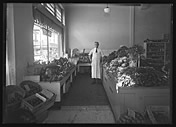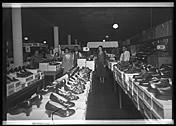|
Itinerant photographers usually specialized in one type of photography, whether traditional portraits, postcards of residences, or street photography. Photographs from each of these genres can tell us much about certain places and people but very little about the photographers. They tell us only slightly more about the culture influencing them and their subjects...
[The Corpus Christi photographer's images] clearly describe a variety of rooms filled with consumer goods—the physical details of material culture. Even more important, they show the people who owned and worked in those rooms in the context of their professional environment... Initially, the Corpus Christi pictures functioned as objects exchanged for currency, as a money-generating product for the photographer. Once purchased, they became family mementos pasted into scrapbooks or albums, kept in drawers or boxes along with other family photographs, framed and hung from the wall of the businesses pictured, or even nailed directly to the wall. Later they served as historical records, occasionally appearing in local newspaper articles announcing the remodeling of a store's interior (and nearly always as the "before" picture) or its permanent closing. (p. 25)
Unlike an independent photographer...an itinerant was necessarily concerned with making a daily profit from his work. The best way to insure a profit was to photograph several people at once. While the cost for exposing a picture of one person was the same as that for a large group, the potential sales from the group pictures were much greater. When it was not possible to photograph a large group, an itinerant could still maximize his money-making potential by photographing the various departments of each business. For instance, after photographing the store clerks he might then photograph the owner in his office, the truck driver next to the delivery truck, or the people employed in the warehouse. A good example of this approach [with the Corpus Christi photographer] is the large number of photographs made at the Nueces County Courthouse, located in downtown Corpus Christi. The courthouse pictures, probably made in a single day or two, show the full range of this itinerant's abilities. Here are large group portraits, individuals at their desks, and other groups of various sizes. He was able to convince nearly everyone, it seems, to have their pictures made, from the county judge and sheriff to county clerks, surveyors, and secretaries. (p. 42)
Because he walked into a business unannounced, without an appointment to photograph a place or its employees, the itinerant made pictures that are more accurate representations of 1930s business environments than photographs taken by hired commercial photographers. Storeowners had little opportunity to clean or rearrange their displays, office workers to clean their desks, or employees to put on clean uniforms or their best clothes. If a person's clothes were soiled from his work, then they appear so in the photograph; if the floors were dirty or the paint peeling, they appear thus in the itinerant's picture. By contrast, when a business hired a commercial photographer to photograph the staff, all uniforms were spotless, all surfaces were shining and often, freshly painted. The resulting pictures, when considered as documentary evidence of working life and work environments, are little more than glossy advertisements for the business. In fact, such pictures were generally taken for advertisements, to announce a new location or remodeling of a store, or perhaps to include in an annual report. (pp. 53-4)
[Studio photographers] began pushing for city ordinances as early as 1915 in an effort to regulate their itinerant competition. The Professional Photographer's Association trade journal The Professional Photographer...frequently published articles, notices, and correspondence concerning these city ordinances. By the 1930s their efforts to regulate itinerants increased to the point where they tried not only to restrict their activities, but in some cities to eliminate them and their inexpensive pictures. With the creation of the National Recovery Administration in 1933, studio photographers found an opportunity to control this unwanted—and to them, unfair—competition through federal and state laws along with local ordinances. The state codes could help the studios stay afloat financially by stabilizing wages and prices but only if itinerants and their lower prices were eradicated...
By [early] 1934, The Professional Photographer regularly published actual city ordinances designed to "act as an effective weapon against the itinerant photographer." (iv) ... [At this time] Corpus Christi had no city ordinance governing itinerant photographers. The itinerant photographer must of known this when he came to the city; perhaps he felt he found an opportunity to work that was disappearing in other cities, or was at the least becoming a more expensive and difficult undertaking. (pp. 48-9, 51)
1 / 2
(iv) The Professional Photographer, v. 53 (February 5, 1934), p. 86.
| | | |

Biel's Self-Service Grocery

Edison Dry Goods

Constable's Office

Union Central Life Insurance

Unidentified auto and marine shop
|